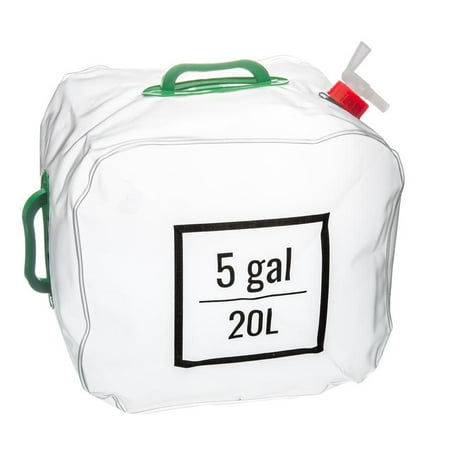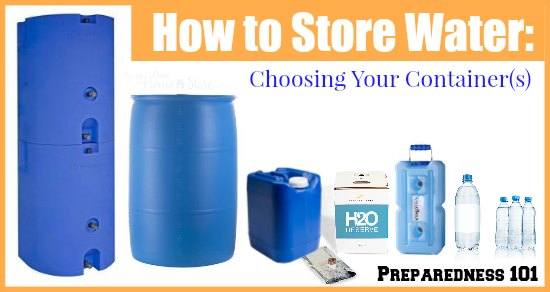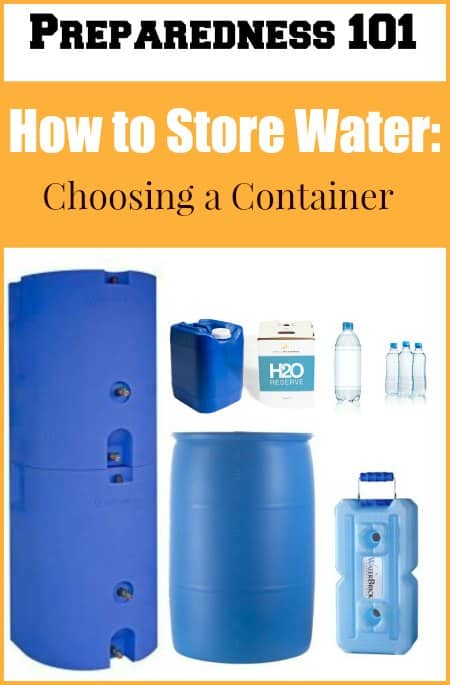The most basic requirement for human survival is access to water. An average person can go three to four days without water. It is now much simpler to find a clean supply of water and effectively store it thanks to contemporary technologies.
You should now have short and long-term goals of exactly how much water you want to store for your family, but how you store that water is important as well. While there is no real “one-size-fits-all” solution, there are some general principles and ideas that you should consider when storing water for your family. This is helpful whenever there is a water shortage after a typhoon or any calamities.
How to Store Water
From my own experience living without water I’ve learned a few important things:
- Variety in the size of storage containers is important
- Don’t forget to think about how you will access your water if you need it
- Knowing your water is safe to drink is essential.
Today, I want to talk about and compare the various water storage containers available. I’ll share the pros and cons of each of them (since there is no perfect solution) and hopefully help you decide which containers are right for you in your situation. Your choices may change over time depending on your overall preparedness, financial situation, and resources.
Next week, we will talk about how to keep your stored water safe once it is in those containers.
General Tips About Storing Water
Different size containers will work better for different situations. So, again, considering exactly what you are preparing for will help you get your priorities straight and store water in the best containers for your situation.
One guiding principle should be variety is key! Don’t put all your eggs in one basket. For example, the 5- gallon (or other large) barrel doesn’t trump all! If you need to evacuate (and can do so in your vehicle) you will want water containers that you can quickly grab and put in your car. If you have to evacuate on foot, you will want smaller water bottles, boxes, or pouches. Ultimately, you should have water stored in various size containers.
Second, think about how you will access your water when/if you need it. Most people I talk to who have water stored have not thought about this aspect. I didn’t think about it when I started working on emergency preparedness!
In fact, the first time I went to rotate a 55-gallon barrel of water, I realized I had NO CLUE about how I was going to get all the water out of it. It weighed over 460 pounds! It took two of us to tip it over and there was no controlling where the water went. Luckily, we didn’t NEED the water (we were just rotating it), but if we had, I would have cried!
If you choose to store water in large barrels, make sure you have a pump or siphon in order to get the water out. Otherwise, the water you store will be nearly useless.
Third, if you choose to store some medium-sized containers such as a 5-gallon jug or water brick, I highly suggest having a spigot for each one.
If you are using your stored water at home, the spigot not only allows you to access the water easier but will also make things much more “normal.” I found this out when I lived on my stored water for a few days. It was wonderful to replace each sink with a jug & spigot and just use water as we normally do (albeit more conservatively).
What to Avoid When Storing Water
Before I get into the smart options for storing water, I wanted to touch on a few not-so-smart options:
1. Non-food Grade Containers
DO NOT USE containers that have had non-food items stored in them (such as bleach containers, cleaners, shampoo bottles, etc.), for drinking water. They may be considered for storing water for cleaning and other non-drinking purposes if clearly marked as such.
The best type of plastic to use for drinking water is high-density polyethylene (HDPE). It is stable and inert and the best option for storing both water and food. You can tell if a container is HDPE by checking the number inside the recycling triangle. If a bottle or container is made of high-density polyethylene it will have a “2” inside that triangle.
Plastics with a #4 (LDPE) or #5 (PP) inside that triangle are also considered safe for food and drink and are a good second option. They typically aren’t as opaque as the HDPE plastic containers and as such, it will be even more important to store them away from light.
Bottles with a #1 (PETE) inside that triangle are safe for water and are typically used for water or juice bottles you buy at the store. However, they are not intended to be reused because of the possibility of bacterial buildup. If you do choose to use them, make certain you clean them exceptionally well.
Do not use plastic containers that have #3 (PVC), #6 (PS), or #7 (Other) inside that triangle. They are possible carcinogens and/ or may leach BPA.
2. Glass containers
This one is more of a personal preference. Glass is not unsafe for water storage; however, it is breakable. If you are preparing for an earthquake or other natural disaster, I recommend staying away from the glass.
3. Milk jugs
Milk jugs you get at the grocery store (or similar jugs even if they hold water or juice) are not a good idea for long-term water storage. First, those that hold milk and juice can be hard to clean thoroughly as they aren’t typically completely smooth plastic.
Second, they disintegrate quickly leaching into your water and possibly letting water leak out. The plastic jugs that non-refrigerated juices come in (like apple juice) are a better option. They need to be cleaned well, but are sturdier and last longer.
Water Storage Container Pros and Cons
All right, on to the pros and cons of the many smart options out there for water storage:
#1: How to Store Water in Large Barrels
Large barrels are available in sizes from 30 gallons up to 320+ gallons. The most popular is a 55-gallon container which you can occasionally find on Craigslist or ebay for amazing prices. If you live in Utah, Macey’s grocery store is the best place to purchase these at around $40-$50 each. Online, I’ve found $60-$70 to be a good price.
If you choose a large, non-gravity-fed barrel, you will need a pump or at least a simple siphon to get the water out. You will also likely need a bung wrench to close and open it.
|
Pros |
Cons: |
|
|
#2: How to Store Water in 3-5 Gallon Jugs
These are typically available in white, somewhat opaque plastic as well as completely opaque blue plastic. There are also spigots available so you can use them at a sink. We use these when camping. If you go with the less expensive/opaque white ones, be sure to store them away from light.

|
Pros |
Cons: |
|
|
#3: How to Store Water in Water Boxes
Water boxes include 5 gallons of mylar bags that are filled with water and then placed inside a stackable box.
|
Pros |
Cons: |
|
|
#4: How to Store Water in Waterbricks
Waterbricks are 3.5-gallon interlocking containers that can be used for food or water and are very popular with the “prepping” crowd. Spigots are available.
|
Pros |
Cons: |
|
|
#5: How to Store Water in Soda/Juice Bottles
If you buy 2-liter soda or non-refrigerated juice (such as apple juice), you can use those containers to store water.
|
Pros |
Cons: |
|
|
#6: How to Store Water in Store-Bought Water Bottles
These are available in small kids (8 oz.) sizes, the typical 16.9 oz bottle, or even large bottles.
|
Pros |
Cons: |
|
|
How Do You Store Water at Home?
Remember, variety is key. Consider what you are preparing for and plan accordingly. You will likely choose to store water in more than one of the above options. Start with what you can afford and move on from there!
Becky is a wildlife enthusiast and pet and livestock care expert with a diploma in canine nutrition. With over a decade of experience in animal welfare, Becky lends her expertise to Simple Family Preparedness through insightful info about pets, livestock, bee keeping, and the practicalities of homesteading.





Misty, Do you have a link to the post on how to store water long term?
Here you go! https://simplefamilypreparedness.com/store-water-making-sure-safe-drink/
Thanks!
Thanks for your tips on choosing the right water containers. I like the tip on knowing how you’re going to access the water. If you’re ever in an emergency situation, have quick access to water is so important.
Are these containers filled with tap water? If so, does each container need any special treatment of the water?
Wouldn’t the water go bad after a few days?
Thanks
This post should help Pam: How to store water so it is safe to drink when you need it.
Thank you Misty for sharing. The loner we prepared the less often we consider the basic building blocks of life such as water and food. You wrote a good article that will inform many.
It is nice to see what your are sharing…even this old lady learned something new everyday, thanks, Rhonda
I bought the 7 gal stackable containers. They have spigots. If you search on goggle you can find at good price. I think Blairs farmstead and fleet had best price. Blain # 140306
Thanks Rick!
I keep 2 and three liter bottles in the freezer. Don’t know if it effects the storage time, but it gives me extra cool time if the electric goes out. I rotate them just as often by filling the dogs’ bowls.
I do that too! Great minds think alike!
We bought one of those metal racks for stacking three 55-gallon barrels on their sides. This is space-efficient and we use a water-stabilizing chemical in our barrels to keep the water potable over a long period of time. However, the downside to using this rack is that two of our barrels right away developed a slow leak at the lower bung even when the bungs were re-tightened. The dripping is no big deal as far as potential water damage because the drips of water evaporate before they reach the tile floor. When we change out the water from these barrels, we are going to try sealing the bung threads with Teflon strips to see if this will stop the leaks.
Other than water barrels, we have about 30 packs of bottled water stacked in closets, some 2.5 gallon water jugs and two of those big plastic bladders that fit inside a bath tub for temporary water storage.
In the summer here in the Mohave desert we always make sure each vehicle has a 24-pack of bottled water, just in case we get stuck somewhere and have to wait hours for a tow truck.
I have a similar (possibly the same) system Linda! Sounds like you have a great amount of water!
What about using the clear poland spring stackable one gallon bottles? (no handles)
I’m not familiar with them Diana, but if they are a food grade, high quality plastic, they should work well.
Sorry Misty, I have had my water barrels for awhile now, at least 2 years. I know you said don’t fill them, but they are already to go if I need them.
Love these classes.
Good for you! One step ahead!
I have 4 55gal barrels and I lay them on there sides. I built a frame to hold 2 and I put a hose in one hole and connected that barrel in the bottom barrel. I have a ball valve on the bottom barrel and that is how I can get water without using a siphon pump. I rotate my water every 6 months. I don’t put anything in the water because I rotate the water in and out. It’s easy to fill them back up, Connect hose on the top barrel and fill them both at the same time.
I have a similar system that I just recently got, but I’m not talented enough to have made it. 😉 https://youtu.be/wYwgS8bJsrQ
I love your class…very good info and enjoy waiting each week for the next class. Thanks for all your hard work for the benefit of others.
You are welcome Joyce! Thank for letting me know it is helpful!
PPSS – Rob There are several documents available for download, that cover wind and solar well pumps from https://formerlynmurbanhomesteader.weebly.com/water–sanitation.html
PS – Back in the late 1990’s a law was passed that required all plastic bottles containing liquid for human consumption of 2 liters or less, be made of “biodegradable plastic”. This law went into effect around 2004.
Bringham Young University did a study on these new biodegradable plastic bottles and found that in 2-3 years all the water in the bottles had the taste tainted by the plastic and it could not be refreshed. Between 4-6 years over half of the bottles had degraded enough to leak.
We have a well, not city water. What is the best way (outside of a generator) to use the well in case the power is out for say 3-6 months? I thought about a hand pump, but is this even possible with it currently having a submersed pump?
Thanks, Rob.
Honestly Rob, I’m not sure. I don’t have much experience with wells. I will ask on my facebook pages and see if I can get an answer for you!
Okay, you can see some of the answers I got from my facebook community here Rob: https://www.facebook.com/YourOwnHomeStore/posts/956777970999647
Most folks I know use either a small wind turbine or solar panel, with a battery and a transfer switch. The power needed to power your well pump is minimal so many of the DIY turbines and solar panels will work. The expense will be the transfer switch, which can be automatic (most expensive) or manual.
One homesteading friend of mine also has a well cistern that is filled before water goes to the home. This cistern has a hand pump for worst case scenarios.
THanks for the help here!